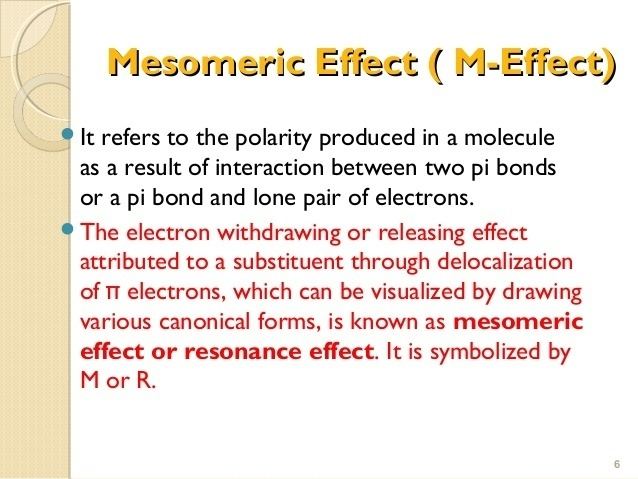 | ||
Mesomeric effect part 1 gen organic chemistry for xi xii jee main jee advance aipmt
The mesomeric effect in chemistry is a property of substituents or functional groups in a chemical compound. The effect is used in a qualitative way and describes the electron withdrawing or releasing properties of substituents based on relevant resonance structures and is symbolized by the letter M. The mesomeric effect is negative (–M) when the substituent is an electron-withdrawing group and the effect is positive (+M) when based on resonance and the substituent is an electron releasing group.
Contents
- Mesomeric effect part 1 gen organic chemistry for xi xii jee main jee advance aipmt
- Mesomeric effect
- Mesomerism in conjugated systems
- References
+M EFFECT ORDER
- O > -NH2 > -NHR > -NR2 > -OH > -OR > -NHCOR > -OCOR > -Ph > -F > -Cl > -Br > -I
-M EFECT ORDER
-NO2 > -CN > -CHO > -C=O > -COOCOR > -COOR > -COOH > -CONH2 > -COO−
The net electron flow from or to the substituent is determined also by the inductive effect. The mesomeric effect as a result of p-orbital overlap (resonance) has absolutely no effect on this inductive effect, as the inductive effect has purely to do with the electronegativity of the atoms and their topology in the molecule (which atoms are connected to which).
The concepts of mesomeric effect, mesomerism and mesomer were introduced by Ingold in 1938 as an alternative to Pauling's synonymous concept of resonance. "Mesomerism" in this context is often encountered in German and French literature but in English literature the term "resonance" dominates.
Mesomeric effect
Mesomerism in conjugated systems
Mesomeric effect can be transmitted along any number of carbon atoms in a conjugated system. This accounts for the resonance stabilization of the molecule due to delocalization of charge. It is important to note that the energy of the actual structure of the molecule, i.e. the resonance hybrid, may be lower than that of any of the contributing resonance structures. The difference in energy between the actual inductive structure and the worst kinetic structure is called the resonance energy or resonance stabilisation energy. Mesomeric effect is completely different from inductive effect.
